

An encyclopedia of Middle-earth and Numenor

|
|
|
|
|
|
|
|
|
|
|
|
|
|
| |
|
 |

An encyclopedia of Middle-earth and Numenor |
 |

ArodHorse of Legolas. Arod originally belonged to a Rider of Rohan, but his master was slain in a battle with Orcs near Fangorn Forest at dawn on February 29, 3019 of the Third Age. The next day, Eomer lent Arod to Legolas and another horse named Hasufel to Aragorn on the condition that they later bring the horses to Meduseld. Arod was a fiery and restive horse, but Legolas rode him easily without saddle or rein. Gimli was not so comfortable on Arod, and he clung to his friend uneasily. The Three Hunters rode the edge of Fangorn Forest seeking Merry Brandybuck and Pippin Took. During the night, a strange old man appeared at their campsite and then disappeared. Arod and Hasufel dragged their pickets and ran away. They heard Shadowfax, the lord of horses, and ran to greet him. The next day when Gandalf whistled to call Shadowfax, Arod and Hasufel returned as well. Legolas rode Arod to Meduseld and on to Helm's Deep. When Aragorn decided to take the Paths of the Dead, Legolas went with him, but Arod was reluctant to enter the Dark Door. Arod trembled in fear until Legolas laid his hands on the horse's eyes and sang to him. Arod then followed Legolas through the tunnels as the Dead gathered behind them. Legolas and Gimli rode Arod in the funeral procession of King Theoden from Minas Tirith to Meduseld. Names &
Etymology: Sources:
|
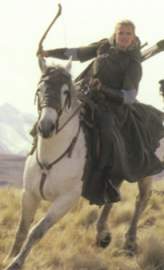 |
Horse of Hurin. Arroch was ridden by Hurin to the Battle of Unnumbered Tears in 472 of the First Age. In that battle, Hurin was captured by Morgoth, and Arroch was apparently either killed or lost. When Hurin did not return home, his wife Morwen hoped in vain to hear Arroch neighing indicating that her husband had returned.
Names &
Etymology:
The name Arroch means "noble
horse" in Sindarin from
ar meaning "high, noble, royal" and roch
meaning "horse."
Sources:
Unfinished
Tales: "Narn I Hin Hurin," p. 65, 70
The Children
of Hurin: "The Childhood of Turin," p. 50-51; "The Departure of Turin,"
p. 70
The Silmarillion:
"Appendix - Elements in Quenya and Sindarin Names," entries for ar(a)
and roch
Asfaloth |
Asfaloth in the New Line Film |
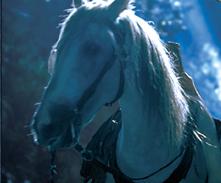
Horse of Glorfindel. Asfaloth was a white horse whose pace was light and smooth but swift. Glorfindel rode Asfaloth using a saddle with stirrups and a headstall studded with jewels.
On October 9, 3018 of the Third Age, Glorfindel left Rivendell riding Asfaloth in search of Frodo Baggins. The Elf-lord rode his horse down the Great East Road to the Last Bridge, where they encountered three Nazgul on October 11. They pursued the Nazgul westward and encountered two more before returning to pick up Frodo's trail. On October 18, they caught up to the Hobbits and Aragorn, and Glorfindel set the wounded Frodo upon Asfaloth.
As they approached the Ford of Bruinen on October 20, the Nazgul appeared. Asfaloth leaped forward, but Frodo reined the horse in, feeling a strange reluctance to flee. Then Glorfindel called out, "Noro lim, noro lim, Asfaloth!" and the horse ran swiftly down the Road, outpacing the steeds of the Nazgul. Asfaloth passed right in front of one of the Nazgul and then plunged into the waters of the Bruinen, carrying Frodo across the Ford to the edge of Rivendell.
Asfaloth turned and neighed fiercely at the Nazgul on the opposite bank. Frodo, compelled by the Ring, remained facing them but he resisted their command to give up saying, "By Elbereth and Luthien the Fair, you shall have neither the Ring nor me!" (FotR, p. 226-7) Asfaloth reared and snorted as the Nazgul approached, but then the waters of the Bruinen rose commanded by Elrond and Gandalf and the Nazgul were swept away.
Names &
Etymology:
The meaning of the name Asfaloth
is
not known. It may be derived from the root phal or phálas
meaning "foam" and the word loth meaning "flower, white blossom."
Noro lim - Glorfindel's command to Asfaloth - means "run swift." (Reader's Companion, p. 195)
Movie Note:
In Peter Jackson's film version
of The Lord of the Rings,
Asfaloth was ridden by Arwen.
Sources:
The Fellowship
of the Ring: "Flight to the Ford," p. 221-27
Letters
of J.R.R. Tolkien: Letter #211
The History
of Middle-earth, vol. V, The Lost Road and Other Writings: "The Etymologies,"
PHAL/PHÁLAS
and LOT(H) entries
The History
of Middle-earth, vol. X, Morgoth's Ring: "Myths Transformed," p. 380
The Lord
of the Rings: A Reader's Companion by Wayne G. Hammond and Christina
Scull: "Flight to the Ford," p. 195
Bill the Pony |
Bill the Pony in the New Line Film |
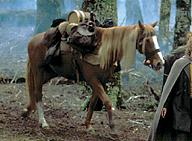
Pony belonging to the Hobbits of the Fellowship. The pony originally belonged to Bill Ferny, an unsavory character in Bree, who mistreated the animal and did not feed him properly. When Merry Brandybuck's ponies were let out of the stables at the Prancing Pony, Barliman Butterbur bought the pony from Ferny for twelve silver pennies as compensation for Merry's loss. This price was three times the pony's worth, but Butterbur also gave Merry an additional eighteen pence for his trouble.
Although the pony technically belonged to Merry, it was Sam Gamgee who cared for the animal and gave him the name Bill. Bill's health and spirit improved under Sam's care, and the stay at Rivendell worked wonders. Sam claimed that Bill could nearly talk, and would if he stayed at Rivendell much longer.
Bill was used mainly as a pack-animal. However, when Frodo became ill from the Morgul-wound, Bill carried him for much of the way between Weathertop and Rivendell. Bill became adept at picking out paths through the rough terrain to spare Frodo from being jolted.
When the Fellowship left Rivendell, Sam insisted that Bill come along or the pony would pine away. When the weather turned foul, Bill proved useful by carrying extra firewood and acting as a shield for the Hobbits against the driving snow.
But when the Fellowship decided to enter the Mines of Moria, Bill had to be left behind. Gandalf gave the pony a blessing to help him find his way back to Rivendell.
"Go with words of guard and guiding on you," he said. "You are a wise beast, and have learned much in Rivendell. Make your ways to places where you can find grass, and so come in time to Elrond's house, or wherever you wish to go."
The Fellowship of the Ring: "Journey in the Dark," p. 317
Sam tearfully said goodbye to Bill as the Fellowship divided up the pony's burdens. Suddenly, the Watcher in the Water attacked the Fellowship and Bill bolted in fear. Sam had to choose between running after the pony or saving his master. Sam went to Frodo's aid, but worried about the fate of Bill.
After the quest was completed, Sam's worries were put to rest. He was delighted to discover that Bill had survived and had made his way to Bree. Sam took Bill back to the Shire with him. When the Hobbits encountered the pony's former master Bill Ferny, Bill the Pony gave him a kick. Sam rode Bill to the Grey Havens to say farewell to Frodo, so the pony that had served the Fellowship was present at the end of the Fellowship in Middle-earth.
Sources:
The Fellowship
of the Ring: "A Knife in the Dark," p. 190-91; "Flight to the Ford,"
211-16; "The Ring Goes South," p. 293, 301, 303; "A Journey in the Dark,"
p. 311, 315-22
The Return
of the King: "Homeward Bound," p. 273-74; "The Grey Havens," p. 307
Pony belonging to Merry Brandybuck. Bumpkin was one of the five ponies that Merry had ready at Crickhollow for the Hobbits to use on their journey. When they set out on September 26, 3018 of the Third Age, each Hobbit rode a pony and the fifth carried their extra baggage.
At the house of Tom Bombadil, the ponies got to know Tom's pony Fatty Lumpkin, and when the ponies became frightened in the fog on the Barrow-downs, they ran off to find their friend. Tom called the ponies by names he had given them - Sharp-ears, Wise-nose, Swish-tail, Bumpkin, and White-socks - and they returned to the Hobbits still bearing their burdens.
At the Prancing Pony in Bree during the night of September 29, Merry's ponies were let out of the stables in an attempt to delay the Hobbits' departure. The five ponies ran off to the Downs in search of Fatty Lumpkin. They stayed with Tom Bombadil for a while, but when Tom learned what had happened, he sent the ponies to Barliman Butterbur. The ponies remained in Bree, where they worked hard but were well cared for by Bob.
Names &
Etymology:
The name Bumpkin may be derived
from the Middle Dutch
bommekijn meaning "little barrel."
Sources:
The Fellowship
of the Ring: "The Old Forest," p. 120; "Fog on the Barrow-downs," p.
155-56; "A Knife in the Dark," 190-91
The Lord
of the Rings: A Reader's Companion by Wayne G. Hammond and Christina
Scull: "Fog on the Barrow-downs," p. 145
Pony belonging to Tom Bombadil. Tom did not ride Fatty Lumpkin very often, but instead let the pony roam freely in the hills of the Barrow-downs. On the night of September 28, 3018 of the Third Age, when the ponies belonging to Merry Brandybuck became frightened in the fog on the Barrow-downs, they ran off to find Fatty Lumpkin. Lumpkin calmed the other ponies down and together they returned when Tom called them. Tom rode Fatty Lumpkin when he escorted the Hobbits to the Great East Road.
When Merry's ponies were set loose from the stables at the Prancing Pony in Bree during the night of September 29, they once again ran off in search of Fatty Lumpkin. The ponies stayed with Tom Bombadil for a while, but were then sent to Barliman Butterbur.
Sources:
The Fellowship
of the Ring: "Fog on the Barrow-downs," p. 155-56; "A Knife in the
Dark," 191
Felaróf |
Tapestry of Felarof and Leod from the New Line Film |
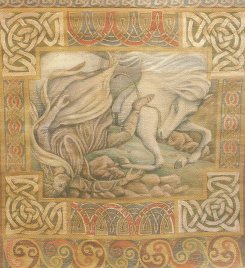
Ancestor of the mearas - the great horses of Rohan. Felarof was a beautiful white horse and he was strong and swift and proud. It was said that Felarof came from a line of horses whose sire was brought to Middle-earth from the Undying Lands by the Vala Orome.
Felarof was a wild horse. As a foal, Felarof was captured by Leod of the Eotheod, who lived in the north near the source of the Anduin. When Felarof was fully grown, Leod tried to mount him, but the horse threw him. Leod struck his head and died, and his son Eorl vowed to avenge his death.
Eorl tracked Felarof down and called to him, and the horse came. Eorl said that Felarof owed him a weregild - meaning compensation for his father's death. Felarof was able to understand the language of Men, and he submitted to Eorl and gave up his freedom. He allowed no one but Eorl to ride him, and he wore no bit or bridle.
In 2510 of the Third Age, Eorl rode Felarof to the aid of Gondor at the Battle of the Field of Celebrant. Afterwards, the Eotheod were given the land of Rohan and Eorl became the first King. Felarof had the life-span of a Man. He was buried in the mound of Eorl, who died in battle in 2545.
Felarof's descendants the mearas were magnificent, long-lived horses. The most famous of these was Shadowfax.
Names &
Etymology:
Felarof was called Father of
Horses because the mearas were descended from him. Eorl called him
Mansbane
because he caused the death of his father.
Felaróf is a poetic
Anglo-Saxon word meaning "very valiant, very strong" from fela meaning
"very" and róf meaning "valiant, strong." The name was given
by Eorl.
Sources:
The Two
Towers: "The Riders of Rohan," p. 38; "The King of the Golden Hall,"
p. 112
Appendix
A of The Lord of the Rings: "The House of Eorl," p. 346, 349
Unfinished
Tales: "Cirion and Eorl," p. 299, 314 note 28
Old English
FirefootHorse of Eomer. Firefoot was Eomer's mount during the War of the Ring. On the way to Helm's Deep, Gimli the Dwarf rode on Firefoot with Eomer. Source:
|
Eomer
with Firefoot
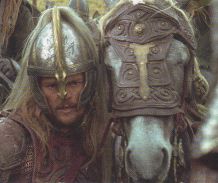 |
Horse ridden by Aragorn. Hasufel was a great dark-grey horse. He originally belonged to Garulf, a Rider of Rohan who was killed in a battle against a band of Uruk-hai and Orcs near Fangorn Forest at dawn on February 29, 3019 of the Third Age. The next day, Eomer lent Hasufel to Aragorn and Arod to Legolas and Gimli on the condition that they later bring the horses to Meduseld.
Aragorn rode Hasufel to the edge of Fangorn Forest seeking Merry Brandybuck and Pippin Took. During the night, a strange old man appeared at the Three Hunters' campsite and then disappeared. Hasufel and Arod dragged their pickets and ran away. They heard Shadowfax, the lord of horses, and ran to greet him. The next day when Gandalf whistled to call Shadowfax, Hasufel and Arod returned as well.
Aragorn brought Hasufel to Meduseld as he'd promised Eomer. He then rode Hasufel to Helm's Deep, where the horse bore him during the charge of the Eorlingas at dawn on March 4, 3019. On March 6, Halbarad and the Rangers of the North brought Aragorn's own horse Roheryn to him. Aragorn then rode Roheryn to the Paths of the Dead and beyond.
Names &
Etymology:
Hasufel means "grey coat"
from the Old English hasu meaning "grey" and fel or fell
meaning
"skin."
Sources:
The Two
Towers: "The Riders of Rohan," p. 41-42, 45-46; "The White Rider,"
p. 91, 107-9; "Helm's Deep," p. 144-46
The Return of the King: "The Passing of the Grey Company," 51, 55
Father of Snowmane, who was the horse of King Theoden.
Source:
The Return
of the King: "The Battle of the Pelennor Fields," p. 120
Noble breed of horses of the Kings of Rohan. The mearas were strong, swift, and tireless. They were intelligent and at least some among them could understand the speech of Men. They had long lives, equivalent to the average lifespan of Men.
The mearas were believed to have originated in the Undying Lands. According to legend, the sire of the mearas was brought to Middle-earth by Orome, the huntsman of the Valar.
The mearas of Rohan were descended from Felarof - a wild horse from the northern Vales of the Anduin. Leod of the Eotheod captured Felarof but the horse threw him and he was killed. Leod's son Eorl tamed Felarof and rode him to the Battle of the Field of Celebrant in 2510 of the Third Age. Afterwards, Eorl became the first King of Rohan.
Only the Kings of Rohan and their sons could ride the mearas. But during the War of the Ring, Gandalf tamed Shadowfax, the chief of the mearas, whom no one else had been able to mount. Shadowfax bore Gandalf throughout the war. After Sauron was defeated, Gandalf left Middle-earth and Shadowfax accompanied him into the West from whence the ancestors of the mearas had come.
Names &
Etymology:
The Old English word mearas
is the plural of mearh meaning "horse."
Sources:
The Fellowship
of the Ring: "The Council of Elrond," p. 275-76
The Two
Towers: "The Riders of Rohan," p. 38; "The White Rider," p. 108; "The
King of the Golden Hall," p. 112-13
Appendix
A of The Lord of the Rings: "The House of Eorl," p. 346
Unfinished
Tales: "Cirion and Eorl," p. 311 note 6, 314 note 28
The Letters
of J.R.R. Tolkien: Letter #268
Horse of Fingolfin. Rochallor was a great, swift horse. In 456 of the First Age after the Battle of Sudden Flame, Fingolfin rode Rochallor across Anfauglith to Angband. Fingolfin challenged Morgoth to single combat, and Rochallor remained beside his master during the long struggle. After Fingolfin was slain, wolves attacked Rochallor but the horse outran them back to Hithlum. Then Rochallor's heart broke and he died.
Names & Etymology:
The name Rochallor contains the
Sindarin word roch meaning "horse."
Sources:
The
Silmarillion:
"Of the Ruin of Beleriand," p.153
The History of Middle-earth, vol. XI, The War
of the Jewels: "The Grey Annals," p. 55-56, 125
Horse of Aragorn. Roheryn was strong, proud, and rough-haired. The horse was given to Aragorn by Arwen.
During the War of the Ring, Roheryn was brought from the North by Halbarad and the Dunedain when they came to find Aragorn in Rohan on March 6, 3019 of the Third Age. Before that time Aragorn had ridden Hasufel, a horse given to him by Eomer. Aragorn led Roheryn through the Paths of the Dead and brought him to the Battle of the Pelennor Fields.
Names &
Etymology:
Roheryn means "horse of the
lady" in Sindarin from roch meaning "horse" and híril meaning
"lady."
Sources:
The Return
of the King: "The Passing of the Grey Company," p. 51, 55
The Silmarillion:
"Appendix - Elements in Quenya and Sindarin Names," entries for heru
and roch (The roch entry explains that Aragorn received the
horse from Arwen.)
Shadowfax |
Shadowfax in the New Line film |
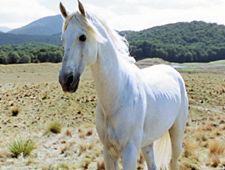
Greatest of all horses at the end of the Third Age; steed of Gandalf. Shadowfax was the chief of the magnificent breed of horses known as the mearas. The mearas were descended from Felarof, a wild horse tamed by Eorl, the first King of Rohan. It was believed that the ancestors of the mearas were brought to Middle-earth from the Undying Lands by Orome, one of the Valar.
Shadowfax was a beautiful horse. In the daylight his coat appeared silver, while at night it was a shadowy grey that made Shadowfax nearly invisible in the dark. He was light-footed and extremely swift and could run great distances without tiring.
Shadowfax was the finest horse in Rohan, but no one had ever been able to ride him. On September 20, 3018 of the Third Age, Gandalf met with King Theoden of Rohan to warn him of Saruman's treachery. Theoden would not listen to Gandalf and threw him out, telling him to take any horse and go.
On September 21, Gandalf saw Shadowfax running in the fields, and over a period of three days he persuaded the horse to bear him. Shadowfax would not wear a saddle or bridle, so Gandalf rode bareback. They went north at great speed, traveling all the way from Rohan to the Shire in only six days from September 23 to September 28.
In the rough terrain of the Ettenmoors, Gandalf released Shadowfax. Shadowfax returned home, arriving in Rohan on February 23, 3019. But Shadowfax had become friends with Gandalf and would come if the Wizard called him.
On February 30, Shadowfax was in the south of Rohan when he became aware that Gandalf was directing his thoughts to him, bidding him to come quickly to Fangorn Forest. During the night, Shadowfax encountered Arod and Hasufel - the horses of Aragorn and Legolas that had gone astray from their riders. The two horses greeted Shadowfax with joy. The next morning Gandalf whistled and Shadowfax came to him, bringing Arod and Hasufel along.
Gandalf rode Shadowfax to Meduseld, where he freed King Theoden from Saruman's influence. Theoden offered a gift to Gandalf in gratitude. Gandalf requested Shadowfax and Theoden agreed.
Riding Shadowfax, Gandalf gathered the scattered Riders of Rohan and brought them to the Battle of Helm's Deep at dawn on March 4. When Saruman's forces saw the White Rider descending down the slope toward them, they were terrified. The Men surrendered and the Orcs fled into the forest of Huorns and were never seen again.
The next day, Pippin Took looked into the palantir and saw Sauron, and Gandalf took the young Hobbit up on Shadowfax and rode swiftly with him to Minas Tirith. When they reached the City, Shadowfax was housed in the stables on the sixth level. On March 10, Gandalf rode out of the City on Shadowfax to rescue Faramir and his Men from the Nazgul. When the Pelennor Fields were overrun by the Enemy forces on March 13, Gandalf rode out once more to the aid of Faramir's retreating rear-guard.
At dawn on March 15, the Great Gate of Minas Tirith was broken and the Lord of the Nazgul rode into the City. Gandalf was there to confront him, mounted on Shadowfax. Shadowfax was the only free horse in Middle-earth who was able to endure the terror of the Nazgul and he stood unmoving. Then the Riders of Rohan arrived and the Lord of the Nazgul departed. Gandalf rode Shadowfax up through the streets of Minas Tirith to save Faramir from the funeral pyre set by Denethor.
After the War of the Ring, in September of 3021, Gandalf rode Shadowfax to the Grey Havens. Gandalf boarded a ship and sailed to the Undying Lands on September 29. He was permitted to take Shadowfax with him and the horse accompanied his rider into the West.
Names &
Etymology:
The name Shadowfax means
"shadowy grey coat." It is an anglicized version of the name Sceadu-faex
in the language of Rohan. The word fax is an obsolete English word
meaning "hair." Also called Shadowfax the Great and Prince of
Horses.
Sources:
The Fellowship
of the Ring: "The Council of Elrond," p. 276-78
The Two
Towers: "The Riders of Rohan," p. 38; "The Uruk-hai," p. 56; "The White
Rider," p. 107-109; "The King of the Golden Hall," p. 110, 113, 117-18,
126-29; "Helm's Deep," p. 133, 147; "The Road to Isengard," p. 148, 156-57;
"The Palantir," p. 201-22, 205-206
The Return
of the King: "Minas Tirith," p. 19-20, 23, 25, 32, 34-35, 41; "The
Passing of the Grey Company," p. 46; "The Muster of Rohan," p. 66; "The
Siege of Gondor," p. 82-83, 93-94, 103; "The Pyre of Denethor," p. 126-27;
"The Houses of Healing," p. 140; "Many Partings," p. 254; "Homeward Bound,"
p. 276; "The Grey Havens," p. 310
Appendix
A of The Lord of the Rings: "The House of Eorl," p. 346
Appendix
B of The Lord of the Rings: "The Tale of Years," p. 372
"Nomenclature
of The Lord of the Rings," entry for Shadowfax
The History
of Middle-earth, vol. IX, Sauron Defeated: "The Epilogue," p. 120,
123 (on Shadowfax accompanying Gandalf into the West)
The Letters
of J.R.R. Tolkien: Letter #268 (on Shadowfax accompanying Gandalf into
the West)
Pony belonging to Merry Brandybuck. Sharp-ears was one of the five ponies that Merry had ready at Crickhollow for the Hobbits to use on their journey. When they set out on September 26, 3018 of the Third Age, each Hobbit rode a pony and the fifth carried their extra baggage.
At the house of Tom Bombadil, the ponies got to know Tom's pony Fatty Lumpkin, and when the ponies became frightened in the fog on the Barrow-downs, they ran off to find their friend. Tom called the ponies by names he had given them - Sharp-ears, Wise-nose, Swish-tail, Bumpkin, and White-socks - and they returned to the Hobbits still bearing their burdens.
At the Prancing Pony in Bree during the night of September 29, Merry's ponies were let out of the stables in an attempt to delay the Hobbits' departure. The five ponies ran off to the Downs in search of Fatty Lumpkin. They stayed with Tom Bombadil for a while, but when Tom learned what had happened, he sent the ponies to Barliman Butterbur. The ponies remained in Bree, where they worked hard but were well cared for by Bob.
Sources:
The Fellowship
of the Ring: "The Old Forest," p. 120; "Fog on the Barrow-downs," p.
155-56; "A Knife in the Dark," 190-91
SnowmaneHorse of King Theoden of Rohan. Snowmane was the foal of Lightfoot. He was a great white horse. As the steed of the King of Rohan, Snowmane was most likely one of the mearas. During the Battle of Helm's Deep, Snowmane was kept in the inner court of the Hornburg. Then at dawn on March 4, 3019 of the Third Age, Theoden led a charge out of the Hornburg mounted on Snowmane and drove through the enemy ranks. At dawn on March 15, Theoden again led the charge of the Rohirrim onto the Pelennor Fields. He seemed like one of the Valar mounted on his great steed. Snowmane bore Theoden into the thick of battle, but when the Witch-king descended onto the field mounted on a Fell Beast, Snowmane was overcome with terror. The horse reared and was pierced by a black dart and then fell to the ground, crushing Theoden beneath him. The Fell Beast dug its claws into Snowmane but Eowyn slew the creature and she and Merry Brandybuck vanquished the Lord of the Nazgul. Before Snowmane died, the horse rolled off his master, but Theoden was mortally wounded and died on the battlefield. Snowmane was buried on the Pelennor Fields and his grave was marked with a stone that bore an inscription in the languages of Gondor and Rohan:
The grave was known as Snowmane's Howe, and the grass grew long and green there. Names &
Etymology:
Sources:
|
Theoden
on Snowmane
|
Pony belonging to Frodo Baggins. Frodo rode the pony from Minas Tirith home to the Shire in 3019 of the Third Age. When Frodo left the Shire for the Grey Havens on September 21, 3021, he rode the pony for the last time.
Names &
Etymology:
Frodo named the pony Strider after
his friend Aragorn.
Source:
The Return
of the King: "The Grey Havens," p. 307
The pony of Meriadoc Brandybuck. Stybba was a shaggy grey hill-pony. King Theoden gave the pony to Merry when the Hobbit became his esquire. Merry rode Stybba from Helm's Deep to Dunharrow. When the King ordered Merry to stay behind, Merry left Stybba at Dunharrow and secretly rode into battle on Windfola, the horse of Dernhelm. It is not known whether Merry kept Stybba after the War. However, he did ride a pony back to the Shire so it is possible that this pony was Stybba.
Names &
Etymology:
Stybb means "stump" or "stub"
in Anglo-Saxon, so Stybba was no doubt a reference to the pony's
small size.
Sources:
The Return
of the King: "The Passing of the Grey Company," p. 50-51; "The Muster
of Rohan," p. 64-65, 75, 78; "The Scouring of the Shire," p. 278
Lord
of the Rings Dictionary
Pony belonging to Merry Brandybuck. Swish-tail was one of the five ponies that Merry had ready at Crickhollow for the Hobbits to use on their journey. When they set out on September 26, 3018 of the Third Age, each Hobbit rode a pony and the fifth carried their extra baggage.
At the house of Tom Bombadil, the ponies got to know Tom's pony Fatty Lumpkin, and when the ponies became frightened in the fog on the Barrow-downs, they ran off to find their friend. Tom called the ponies by names he had given them - Sharp-ears, Wise-nose, Swish-tail, Bumpkin, and White-socks - and they returned to the Hobbits still bearing their burdens.
At the Prancing Pony in Bree during the night of September 29, Merry's ponies were let out of the stables in an attempt to delay the Hobbits' departure. The five ponies ran off to the Downs in search of Fatty Lumpkin. They stayed with Tom Bombadil for a while, but when Tom learned what had happened, he sent the ponies to Barliman Butterbur. The ponies remained in Bree, where they worked hard but were well cared for by Bob.
Sources:
The Fellowship
of the Ring: "The Old Forest," p. 120; "Fog on the Barrow-downs," p.
155-56; "A Knife in the Dark," 190-91
Pony belonging to Merry Brandybuck. White-socks was one of the five ponies that Merry had ready at Crickhollow for the Hobbits to use on their journey. When they set out on September 26, 3018 of the Third Age, each Hobbit rode a pony and the fifth carried their extra baggage.
At the house of Tom Bombadil, the ponies got to know Tom's pony Fatty Lumpkin, and when the ponies became frightened in the fog on the Barrow-downs, they ran off to find their friend. Tom called the ponies by names he had given them - Sharp-ears, Wise-nose, Swish-tail, Bumpkin, and White-socks - and they returned to the Hobbits still bearing their burdens.
At the Prancing Pony in Bree during the night of September 29, Merry's ponies were let out of the stables in an attempt to delay the Hobbits' departure. The five ponies ran off to the Downs in search of Fatty Lumpkin. They stayed with Tom Bombadil for a while, but when Tom learned what had happened, he sent the ponies to Barliman Butterbur. The ponies remained in Bree, where they worked hard but were well cared for by Bob.
Sources:
The Fellowship
of the Ring: "The Old Forest," p. 120; "Fog on the Barrow-downs," p.
155-56; "A Knife in the Dark," 190-91
Horse of Dernhelm, a Rider of Rohan who was actually Eowyn, niece of King Theoden, in disguise. Windfola was a great grey horse and was easily able to carry two riders when Dernhelm offered to take Merry Brandybuck secretly into battle against King Theoden's wishes. Windfola bore Dernhelm and Merry safely through the charge of the Rohirrim onto the Pelennor Fields, but when the Witch-king descended upon the field mounted on a Fell Beast, the horse threw both riders in terror and fled.
Names &
Etymology:
In Old English, wind means
"wind" and fola mean "foal" or "colt." This is probably a reference
to the horse's speed.
Sources:
The Return
of the King: "The Muster of Rohan," p. 78; "The Battle of the Pelennor
Fields," p. 115
Pony belonging to Merry Brandybuck. Wise-nose was one of the five ponies that Merry had ready at Crickhollow for the Hobbits to use on their journey. When they set out on September 26, 3018 of the Third Age, each Hobbit rode a pony and the fifth carried their extra baggage.
At the house of Tom Bombadil, the ponies got to know Tom's pony Fatty Lumpkin, and when the ponies became frightened in the fog on the Barrow-downs, they ran off to find their friend. Tom called the ponies by names he had given them - Sharp-ears, Wise-nose, Swish-tail, Bumpkin, and White-socks - and they returned to the Hobbits still bearing their burdens.
At the Prancing Pony in Bree during the night of September 29, Merry's ponies were let out of the stables in an attempt to delay the Hobbits' departure. The five ponies ran off to the Downs in search of Fatty Lumpkin. They stayed with Tom Bombadil for a while, but when Tom learned what had happened, he sent the ponies to Barliman Butterbur. The ponies remained in Bree, where they worked hard but were well cared for by Bob.
Sources:
The Fellowship
of the Ring: "The Old Forest," p. 120; "Fog on the Barrow-downs," p.
155-56; "A Knife in the Dark," 190-91